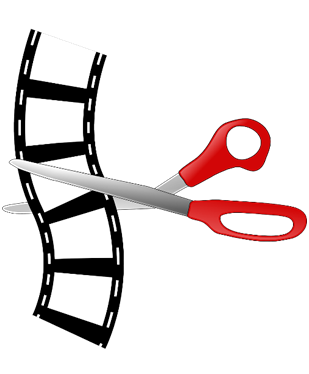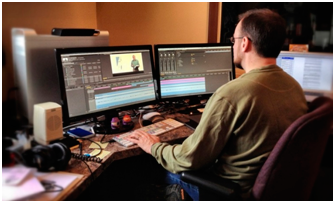Interview with Audio Expert, Ken Theriot
We hung out with world famous voice-over artist Ken Theriot to learn some tips and tricks on recording audio. Ken is a voice actor and founder of Home Brew Audio, a business that teaches anyone how to record professional audio from home. Home Brew Audio caters exclusively to musicians to help them create video narrations, podcasts and other services.
Ken discussed with us how to record and edit high quality audio for your marketing strategy.
Can you tell us more about what you do?
I teach regular people how to create audio. It’s very difficult for most folks to understand the jargon that’s used when teaching audio. It’s overly technical and very confusing.
A lot of people think they have to get some Master’s Degree in audio to make it good. There’s also a common misconception that you need a commercial studio to get something professional. Those guys do a great job but it is possible to record pro audio from home. It’s just about knowing some basic things. I try to make everything as easily understood as possible and show people you don’t have to spend a million dollars to get good audio from home.
See the full interview with COREY PETREE below:
What are good methods for sourcing audio for video production?
There are three essential ways to get good audio:
A typical video maker will be using a camcorder. A lot of camcorders have built in microphones, which are convenient but aren’t very good quality. If your video camera has an external microphone jack, you can attach a mic directly to the camera.
For talking heads or interviews, wireless or wired lapel mics are commonly used. You can also attach things like Beachtek devices, which you plug into the mic jack of the camera. It has two channels and two regular mic plug-ins.
The third way is to record the audio separately from the video. You can do that straight into the computer and put it into a separate track from any other recorded audio. This method is good for replacing audio in post-production. A good practice is to record silence or background noise to create an ambient track for dialogue-replacement so that any sound added later can match the sound recorded in production.
What are some recommended steps for staying organized in post-production?
The more audio sources you have, the more difficult it is to stay organized, which is why it’s important to name your audio files. For example, if it’s a different character, put the name down, if it’s a different time or scene, name that.
I first put the audio into a digital audio work station. ProTools is a popular one. I use Reaper. I edit the audio first and make sure the levels are optimized so it’s loud enough to hear but not too loud. I take out all the extraneous noise, save the audio file, then import the audio to the video editor.
When do you think music is appropriate with video?
If you’re making a dramatic film it’s almost eerie not to have music. We’re used to having music in that context. In a business video, there’s some debate. A lot of people use music for explainer videos but I don’t do that. I don’t feel like it adds much. I want to get the point right across. People do it all the time but that’s a matter of personal taste. In my podcasts, I only have music in the intro and at the end.
What audio advice do you have for anyone just starting out?
Get free audio recording software. Audacity is the most common and extraordinarily capable.
You can get good audio out of a regular old PC mic. You have to learn how to ring the best audio out of the cheapest gear. There’s noise reduction and ways to do it regardless of what you’re using. When you learn that, you can use those techniques with more expensive mics and get the best possible quality. The difference in the sound quality between a PC mic and a larger one, even for $39, is astounding.
It’s important to understand a directional mic vs. a non-directional mic. For directional mics, if you get your mouth really close to the microphone it will improve your sound quality because it’s getting your voice more directly. Once you learn to get the mic placed where it should be, then you go to the software and normalize the audio.
Are you seeing any new developments in the audio industry?
More so in the video industry. People can’t get enough resolution in their videos. We’re seeing virtual reality, 3D video, 4K resolution. When was the last time you heard that much excitement about audio?
I think people just need to figure out how to make better sounding audio with the equipment we already have. There’s a YouTube channel called BadLipReading that replaces original video audio with funny voice-overs. If you pay close attention you can hear that the sound quality is top notch. They pay close attention to background noise. Those people get it. They understand the need for high quality audio.
How did you get into your industry?
Being a musician and being poor. I recorded my first album on a 4-track cassette. When the digital age came and I was able to start recording on a computer I was like “Oh my God! If this was available when I was a teenager, I would have never seen the light of day.” The big leap in audio came when digital became accessible to everybody.
What audio tips do you have for businesses that want to put together marketing campaigns?
I have a video on YouTube called How to Get Good Audio on Your Videos and that explains it all. I’m talking about how to get good audio into your video. I go through the steps of all the technologies you can use to do that. There’s also a company called Wistia that’s all about teaching people how to make top notch videos with good audio.
A big problem that comes with background music is when businesses put a video on websites and YouTube flags it for copyright infringement. What’s your advice on that?
Royalty-free. There are plenty of royalty-free music libraries out there. It’s like putting a picture in a blog. When you pay for the license by going to a royalty-free site you can use anything they have.
Video creation sites like Animoto allow you to upload pictures or video clips and a theme and you choose music from their library. It takes your photos and makes a fancy slideshow for you. All of that music is pre-cleared. Anything you make on Animoto, you can immediately put on YouTube.
Editing the Content - by Corey Petree
What to Know About Hiring Video Editors
CoreyPetree is the co-founder of Story Store Media in Washington, D.C. He’s an award-winning editor, director and motion graphics designer with over 25 years of experience working with companies as big as NASA and National Geographic.
We spoke with him about video editing and troubleshooting for a successful video production.
Can you tell us more about Story Store Media?
My business partner Paul and I were working in the Washington D.C. video production market and we started this business with an emphasis on the quality of the story being told.
What’s it like working with big clients like NASA and National Geographic?
Every particular client has their own culture and they bring their own experience to the production process. We have a broad spectrum of clients, from people who don’t know how to work a camera, to people who’ve been doing it as long as I have.
What are the most important questions to ask when you’re on-boarding a client?
Take into account their experience and guide them accordingly. A client might be an experienced producer and have their own client in mind; they might already have a good idea of what they’re trying to do. On the other end, you may have someone who doesn’t know the first thing about media production. No everyone may understand the impact that a particular production can have on an audience and how everything that is done can influence how the audience is affected. First off, there are three basic questions that we ask:
Who is your audience?
What are they interested in?
What is your message?
Find the place where the answers to the last two questions come together and try to explore that. People create productions with an end in mind. They want to change their audience’s mind about something. Take that into account and also consider the digital context. How is the video going to be distributed?

What are some of the steps you take to prepare for video editing? Do you have a process that you go through?
We deal with clients that have productions of all sorts. Preparing and knowing how your message is going to be delivered and creating a way to make that happen is important. If we’re in a stage where we haven’t shot the footage, we ask the same questions from before to try and understand how this footage is going to enable you to tell a message.
Is there any specific software you’d recommend for people who are new to editing?
We use multiple pieces of software. Software may be irrelevant for someone who is good. It’s really relevant for people who first need to understand fundamental techniques. There are multiple websites that teach editing. Watch lots of movies. Be the person who spoils the movie for everyone around you by focusing on the editing. Learn techniques about video editing. Cut something and go back and look at it in a couple of months and see what you think of it. Experiment and make mistakes. In terms of software, they all will get you there. 99% of edits are straight cuts.

When new programs release new video editing features, do you think they evolve the editing process?
Really, the superpower of video is its emotional power. A webpage will probably not make someone cry when they look at it unless it’s really bad. A piece of video can really move somebody. You can place a camera somewhere and let it be a proxy for someone’s experience. You can put them in a place and let them know what’s going on. That’s an incredible power to have as a filmmaker. It’s important when you’re telling a story to make sure how you’re going to get a certain point across. If footage is poorly shot, you have to be creative and find techniques to make a story out of it.
What techniques can you use to enhance the story?
There are two fundamental types of story, fiction or interview based. You may add graphics to an interview-based video. You may cut to a close-up of hands on a keyboard or a screen. This whole thing of video production is nothing but problem solving. You may plan one thing and then you go out and shoot something different. You may run across a certain point where you want to talk about something new. At that point you may have to go out and shoot B-roll where no one is talking. Sometimes you have to be creative in post-production.
Is there a way to integrate symbolism into video?
Sure. Ask yourself if this is going to be an optimistic piece or a frightening piece? Then you need to choose a color palette. You can color grade things to have a bright optimistic feel or a gloomy feel. Those are subtle techniques to get emotional connections across. If you can tell a visual story, they get the message from two places—the content and the visuals. I’m a big fan of the Coen Brothers’ movies because they are great visual storytellers. What’s also important to remember is that the smaller the budget you have, the more creative you have to be.

What’s a preditor?
It’s a term we use in our market. It’s an editor who is doing part of the job of a producer. When an editor is doing the part of a producer, those are the senior editors who think about the larger questions and that’s what you really want. That’s when you’re doing well.
What do you do if the client insists on something you know is not going to turn out well?
The ability to communicate with your client about their best interests is extremely important. Don’t be married to an idea. You have to be honest with clients, provided you really know what you’re talking about. Make another suggestion. Relating to a client, you have to be respectful and have a sense of humor because you’ve also got to be able to lighten up. If you’ve got a customer and you’ve done your best to convince them of another way of doing things, and you’ve brought them into the creative process, at the end, it’s the client’s dollar and sometimes you have to listen to them.








